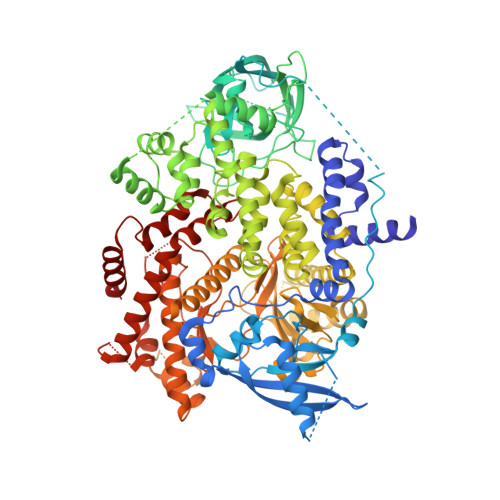(S)-4-(Difluoromethyl)-5-(4-(3-methylmorpholino)-6-morpholino-1,3,5-triazin-2-yl)pyridin-2-amine (PQR530), a Potent, Orally Bioavailable, and Brain-Penetrable Dual Inhibitor of Class I PI3K and mTOR Kinase.
Rageot, D., Bohnacker, T., Keles, E., McPhail, J.A., Hoffmann, R.M., Melone, A., Borsari, C., Sriramaratnam, R., Sele, A.M., Beaufils, F., Hebeisen, P., Fabbro, D., Hillmann, P., Burke, J.E., Wymann, M.P.(2019) J Med Chem 62: 6241-6261
- PubMed: 31244112
- DOI: https://doi.org/10.1021/acs.jmedchem.9b00525
- Primary Citation of Related Structures:
6OAC - PubMed Abstract:
The phosphoinositide 3-kinase (PI3K)/mechanistic target of rapamycin (mTOR) pathway is frequently overactivated in cancer, and drives cell growth, proliferation, survival, and metastasis. Here, we report a structure-activity relationship study, which led to the discovery of a drug-like adenosine 5'-triphosphate-site PI3K/mTOR kinase inhibitor: ( S )-4-(difluoromethyl)-5-(4-(3-methylmorpholino)-6-morpholino-1,3,5-triazin-2-yl)pyridin-2-amine (PQR530, compound 6 ), which qualifies as a clinical candidate due to its potency and specificity for PI3K and mTOR kinases, and its pharmacokinetic properties, including brain penetration. Compound 6 showed excellent selectivity over a wide panel of kinases and an excellent selectivity against unrelated receptor enzymes and ion channels. Moreover, compound 6 prevented cell growth in a cancer cell line panel. The preclinical in vivo characterization of compound 6 in an OVCAR-3 xenograft model demonstrated good oral bioavailability, excellent brain penetration, and efficacy. Initial toxicity studies in rats and dogs qualify 6 for further development as a therapeutic agent in oncology.
- Department of Biomedicine , University of Basel , Mattenstrasse 28 , 4058 Basel , Switzerland.
Organizational Affiliation:

















